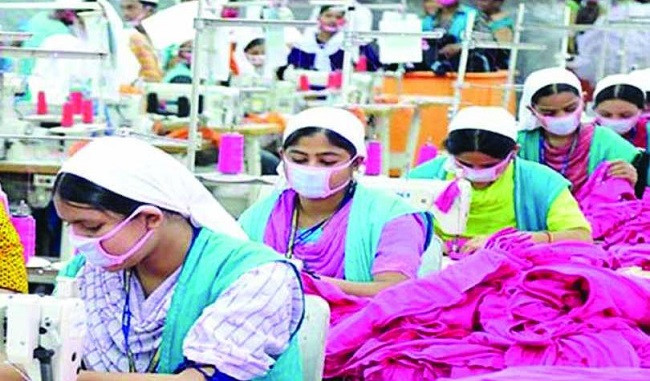Bangladesh’s economy is still in dire straits. Foreign exchange reserves have been declining with the persisting high rate of the US dollar. Inflation pressure remains steep. Amid this, the growth in export and remittance inflow brought some respite to the government. At the same time, the cost of imports fell. This has reduced the existing current account deficit by one-fourth. However, the country’s current account deficit was the highest in the last 51 years in the fiscal 2021-22.
Amid the global economic slump, the US and European Union (EU) markets helped Bangladesh’s export income sustain. The United States topped the list as a single market. On the other hand, Saudi Arabia and the United Arab Emirates (UAE) have always been the top sources of remittance inflow. The United States has replaced United Arab Emirates to occupy the second place. The US may occupy the top spot if the trend of the first 10 months of the current fiscal 2022-23 continues for the rest of the year.
Bangladesh is basically an import-dependent country. The import costs here are much higher than the export revenue. Nearly half of Bangladesh’s total imports come from China and India. As a result, the trade deficit has to be met mainly with remittance. Foreign investment and loans are the two other sources of foreign exchange earnings of the country apart from exports and remittance. The US is also at the top in terms of Foreign Direct Investment (FDI).
According to Bangladesh Bank and Export Promotion Bureau (EPB) data, the US is the destinations of 20 per cent of the country’s total product exports. US investors accounted for 19 per cent of foreign direct investment (FDI) while the total remittance from the US contributes to 16 per cent of the overall total. On the other hand, a 3.75 per cent of total product imports are received from the United States.
Major export destination in the US
The US has long been the single largest market for Bangladesh in terms of product exports. Germany became the top destination for Bangladeshi products for a while, but that did not last long. As many as 20 per cent of Bangladesh’s product exports went to the US market in 2021-22 fiscal. However, 44.60 per cent of total product exports go to the EU. Bangladesh enjoys duty-free facilities for exporting products to this market.
According to EPB data, Bangladesh exported goods worth USD 52.08 billion in the previous fiscal. Of that, the US accounted for the highest export worth USD 10.42 billion. Besides, Bangladesh exported products worth USD 7.59 billion to Germany, USD 4.83 billion United Kingdom, to France USD 2.71 billion and USD 3.17 billion to Spain. Compared to these four countries, the growth in exports to the United States was the highest, at 49 per cent.
Bangladesh exported 86 per cent of the total exports worth USD 10.42 billion were manufactured garments, which amounted to 9.01 billion dollars. Besides, home textiles worth USD 310 million have been exported as well. The US is the destination for 21 per cent of readymade garments and 17.85 per cent of home textiles exported from Bangladesh.
Exports to the US market fell by 8 per cent in the first 10 months of the current fiscal due to global economic crisis. Yet as much as products worth USD 7.94 billion were exported to the country. Of this, readymade garment products accounted for USD 6.95 billion, which is nearly 18 per cent of the total readymade garments export from Bangladesh.
Bangladesh has been adopting various initiatives to boost exports of readymade garment products to non-traditional or new market for over a decade. Cash assistance is also being provided. Still, exports from other countries apart from the US, EU, UK and Canada did not exceed 15 per cent of the total apparel exports. Readymade garments worth USD 6.37 billion were exported to new countries in the previous fiscal. However, the imports of the US alone exceed the combined imports of the products by a margin of USD 2.64 billion.
The president of Bangladesh Garment Manufacturers and Exporters Association (BGMEA), Farooq Hasan told Prothom Alo on Friday, “The US is a vital market for our readymade garment exports. The EU allows us to export any goods other than arms duty-free under the Generalized System of Preferences (GSP). That’s why we currently export almost half of our readymade garment products to the EU. Even though the US does not give us GSP facility, 21 per cent of the apparel products go to the country. We are also trying to increase this.”
The US buyers have been moving their orders from China due to its trade rivalry with China. Again, Vietnam’s apparel exports to the US markets slowed due to the use of Chinese cotton. The purchase orders of these two countries are being transferred to Bangladesh. Referring to this data, Farooq Hasan said, “Bangladesh and US politicians have been talking over various things recently. It is their private matter. We will continue our business. The US is still the biggest market for our readymade garment products.”
China top exporter
According to Bangladesh Bank and EPB data, goods were imported worth USD 75.6 billion (total import including import of export processing zones or EPZ and service sector is USD 89.34 billion) in the fiscal 2021-22. On the contrary the export was worth USD 52.08 billion. Export of service sector is USD 8.88 billion. However, USD 52.47 billion came from the exports and service sectors last year. The remittance inflow was USD 21.03 billion. It constitutes that the entire import expenditure could not be met with the USD 73.39 billion received from exports and remittance leading to deficit of USD 1.81 billion.
According to Bangladesh Bank data, Bangladesh imports the most goods from China followed by India, Singapore, Malaysia, Indonesia, USA, Japan, Brazil, Qatar and Saudi Arabia. The US is in the sixth position in terms of imports.
Bangladesh imported USD 19.35 billion worth products from China and USD 13.69 billion from India in the previous fiscal while it’s import from the US was USD 2.83 billion worth of goods.
Bangladesh mainly imported mineral fuel (USD 790 million), iron and steel (USD 730 million), oilseeds and fruits (USD 440 million), cotton (USD 290 million) and machinery worth USD 130 million from the United States.
Saudi Arabia top remittance source
According to the data of Bangladesh Bank, the country received USD 21.03 billion remittance from different countries in the fiscal 2021-22. Bangladeshi migrant workers in Saudi Arabia sent the highest amount of USD 4.54 billion. The second highest remittance inflow came from the United States, amounted to USD 3.44 billion. The third highest remittance of USD 2.07 billion came from the UAE last year.
People in the US and Europe are under huge pressure due to high inflation caused by the Russia-Ukraine war. Increasing oil price became a saving grace for Middle East economy. In the first 10 months (July-April) of the current fiscal, more remittance came from the United States than from the United Arab Emirates, Kuwait or Qatar. At times, the United States toppled Saudi Arabia. Bangladesh received record USD 3.04 billion remittance from the country. Expatriate Bangladeshis from Saudi Arabia sent the second highest amount of USD3.03billion. However, we will be able to know whether the US can occupy the top position at the end of the current fiscal.
US at the top in foreign investment too
The government is setting up a hundred special economic zones to attract foreign investment. Investors from various countries including China, Japan, India are expressing their interest in building industries in these economic zones. But the US is ahead of other countries in foreign direct investment (FDI) in Bangladesh.
According to the data of Bangladesh Bank, FDI of USD 21.15 billion has arrived in the country till December 2022. Among them, 19.38 per cent or USD 4.1 billion of investment came from the US, which is the highest. Besides, Bangladesh received USD 2.71 billion from United Kingdom, USD 1.84 billion from Singapore, USD 1.46 billion from South Korea and USD 1.35 billion from China.
Of the USD 4.1 billion FDI received from the US, the gas and petroleum sector received USD 2.91 billion, USD 120 million in the textile sector, USD 200 million in banking, USD 170 million in the power sector, USD 240 million in financial institutions, and USD 270 million in insurance.
US importance to go up
Mustafizur Rahman, distinguished fellow of the Centre for Policy Dialogue (CPD), told Prothom Alo, “Our big market is the European Union, an alliance of 27 countries. However, the US is the largest market as a single country. Our products remain competitive in this market even with an average duty of 15 per cent. This is important. Because, Bangladesh will no longer get duty-free benefits in various countries including EU, India, China, Canada if it graduates to the list of developing countries from the list of least developed countries (LDC). So there is concern about exports to these markets. But we do not have worry about this in the US market. This is why; the US will be more important partner after the transition from LDC.”
Mustafizur Rahman further said, “We have a surplus in our trade as exports are high and imports are low with the United States, which is helping to increase our foreign exchange reserves. Besides, the highest remittance is now received from the US.”
He also said, “The US exerts strong influence on international organisations such as the International Trade Organization (WTO) and the World Bank. We are seeking additional benefits for six years after transition from LDC. The US will play a major role for us to obtain those facilities.”
*This report, originally published in Prothom Alo print edition, has been rewritten in English by Farjana Liakat




















